|
|
|
Sort Order |
|
|
|
Items / Page
|
|
|
|
|
|
|
| Srl | Item |
| 1 |
ID:
026784
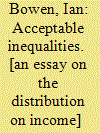

|
|
|
|
|
| Publication |
London, George Allen and Unwin, 1970.
|
| Description |
148p.
|
| Standard Number |
043301614
|
|
|
|
|
|
|
|
|
|
|
|
Copies: C:1/I:0,R:0,Q:0
Circulation
| Accession# | Call# | Current Location | Status | Policy | Location |
| 005437 | 339.2/BOW 005437 | Main | On Shelf | General | |
|
|
|
|
| 2 |
ID:
041085
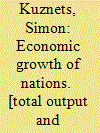

|
|
|
|
|
| Publication |
Massachusetts, Harvard University Press, 1971.
|
| Description |
xii, 363p.
|
|
|
|
|
|
|
|
|
|
|
|
Copies: C:1/I:0,R:0,Q:0
Circulation
| Accession# | Call# | Current Location | Status | Policy | Location |
| 008695 | 338.9/KUZ 008695 | Main | On Shelf | General | |
|
|
|
|
| 3 |
ID:
152176
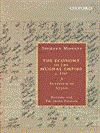

|
|
|
|
|
| Edition |
revised and enlarged ed.
|
| Publication |
New Delhi, Oxford University Press, 2015.
|
| Description |
xii, 476p.: maps, figurespbk
|
| Standard Number |
9780199450541
|
|
|
|
|
|
|
|
|
|
|
|
Copies: C:1/I:0,R:0,Q:0
Circulation
| Accession# | Call# | Current Location | Status | Policy | Location |
| 058994 | 954.0254/MOO 058994 | Main | On Shelf | General | |
|
|
|
|
| 4 |
ID:
147893
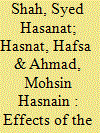

|
|
|
|
|
| Summary/Abstract |
The main focus of this article is to investigate the short- and long-run causal effects of human cost of terror on gross domestic product (GDP), private consumption and private investment in Pakistan by using autoregressive distributed lag techniques. The results confirm the long-run association between the human cost of terror, GDP, private consumption and private investment and suggest that the human cost of terror adversely affects GDP and private investment, and positively influences private consumption in the long run. Furthermore, the results in the study reveal that the human cost of terror negatively affect GDP and private investment and increases private consumption in the short run. The overall findings of the article suggest that the human cost of terror drags the economy down, discourages private investment and distorts the pattern of private consumption in Pakistan.
|
|
|
|
|
|
|
|
|
|
|
|
|
|
|
|
| 5 |
ID:
132520
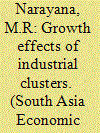

|
|
|
|
|
| Publication |
2014.
|
| Summary/Abstract |
This article develops a simple methodology for calculation of growth effects of industrial clusters at national level and estimates the economic determinants of the clusters' size-class of production by using data on 354 individual industrial clusters in India. Gross value of industrial clusters is indirectly measured and growth effects are calculated within the National Income Accounting framework. Determinants are estimated by using the grouped data on size-class of value of production by clusters. Results show that industrial clusters contributed to India's economic growth of manufacturing sector (or Indian economy) between 8 to 3 per cent (or between 1 to 0.4 per cent) in 2002-2003 and 2003-2004, respectively. Binary Logit estimates show that industrial clusters with modern small scale industries and traditional art and craft products, high and medium heterogeneity, high and medium potential for technology upgradation and exports and those which are market or resource based are the important determinants of size-class of production of clusters. Other things being equal, an improvement in these determinants may contribute to higher gross value added and maximization of economic growth by industrial clusters. This analysis is useful to calculate the determinants of probability of individual clusters belonging to larger size-class of production at the state level. Further, the approach is relevant and applicable to estimate growth effects of industrial clusters in other South Asian countries as well.
|
|
|
|
|
|
|
|
|
|
|
|
|
|
|
|
| 6 |
ID:
182780
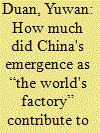

|
|
|
|
|
| Summary/Abstract |
Over time, China upgraded its capabilities to such an extent that it requires less imported materials, components, and services to maintain its central role in the global production network. Consequently, the domestic value added content of its exports has increased over time. Still, value added includes profits, which are partly earned by foreign capital owners, many of whom have set up operations in export processing zones. Such profits can be repatriated, and do not directly enhance the living standards in China. This paper will focus on the extent to which China's exporting activities have contributed to its Gross National Income (GNI), which is a better indicator of economy-wide living standards than GDP. Our results, based on input-output analysis, show that the increase in the share of Chinese GNI of a yuan of Chinese exports from 2002 to 2007 was modest, despite a marked growth of Chinese GDP contained in such a yuan of exports. From 2007 to 2017, however, the continued increase of domestic value added per yuan of exports did actually translate into considerably higher contributions of exports to GNI. Decomposition analyses show that changes in the commodity composition of China's export bundle and changes in the shares of national income in value added were the main cause of the different patterns before and after the financial crisis.
|
|
|
|
|
|
|
|
|
|
|
|
|
|
|
|
| 7 |
ID:
142689
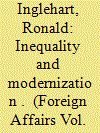

|
|
|
|
|
| Summary/Abstract |
During the past century, economic inequality in the developed world has traced a massive U-shaped curve—starting high, curving downward, then curving sharply back up again. In 1915, the richest one percent of Americans earned roughly 18 percent of all national income. Their share plummeted in the 1930s and remained below ten percent through the 1970s, but by 2007, it had risen to 24 percent. Looking at household wealth rather than income, the rise of inequality has been even greater, with the share owned by the top 0.1 percent increasing to 22 percent from nine percent three decades ago. In 2011, the top one percent of U.S. households controlled 40 percent of the nation’s entire wealth. And while the U.S. case may be extreme, it is far from unique: all but a few of the countries of the Organization for Economic Cooperation and Development for which data are available experienced rising income inequality (before taxes and transfers) during the period from 1980 to 2009.
|
|
|
|
|
|
|
|
|
|
|
|
|
|
|
|
| 8 |
ID:
041079
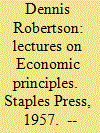

|
|
|
|
|
| Publication |
Staples Press, 1957.
|
| Description |
480p.
|
|
|
|
|
|
|
|
|
|
|
|
Copies: C:1/I:0,R:0,Q:0
Circulation
| Accession# | Call# | Current Location | Status | Policy | Location |
| 011167 | 330.01/ROB 011167 | Main | On Shelf | General | |
|
|
|
|
| 9 |
ID:
093008
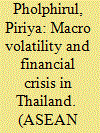

|
|
|
| 10 |
ID:
028504
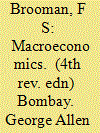

|
|
|
|
|
| Edition |
4th rev. edn
|
| Publication |
Bombay, George Allen and Unwin, 1970.
|
| Description |
384p.pbk
|
| Series |
Minerva Series of Students Handbooks; no.9
|
|
|
|
|
|
|
|
|
|
|
|
Copies: C:1/I:0,R:0,Q:0
Circulation
| Accession# | Call# | Current Location | Status | Policy | Location |
| 013557 | 339/BRO 013557 | Main | On Shelf | General | |
|
|
|
|
| 11 |
ID:
040685
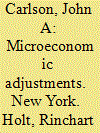

|
|
|
|
|
| Publication |
New York, Holt, Rinchart and Winston Inc, 1970.
|
| Description |
ix, 162 p.
|
| Series |
Principles of economic series
|
|
|
|
|
|
|
|
|
|
|
|
Copies: C:1/I:0,R:0,Q:0
Circulation
| Accession# | Call# | Current Location | Status | Policy | Location |
| 004675 | 339/CAR 004675 | Main | On Shelf | General | |
|
|
|
|
| 12 |
ID:
087783
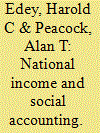

|
|
|
|
|
| Publication |
London, Hutchinson, 1954.
|
| Description |
viii, 222p.
|
|
|
|
|
|
|
|
|
|
|
|
Copies: C:1/I:0,R:0,Q:0
Circulation
| Accession# | Call# | Current Location | Status | Policy | Location |
| 025048 | 339.32/EDE 025048 | Main | On Shelf | General | |
|
|
|
|
| 13 |
ID:
045564
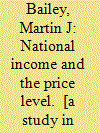

|
|
|
|
|
| Publication |
New York, McGraw Hill Book Company, 1962.
|
| Description |
ix, 278p.
|
|
|
|
|
|
|
|
|
|
|
|
Copies: C:1/I:0,R:0,Q:0
Circulation
| Accession# | Call# | Current Location | Status | Policy | Location |
| 006899 | 339.3/BAI 006899 | Main | On Shelf | General | |
|
|
|
|
| 14 |
ID:
138604
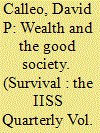

|
|
|
|
|
| Summary/Abstract |
Thomas Piketty’s Capital in the Twenty-First Century has attracted a great deal of attention, and deservedly so. It is a seductive book that soars above the myopia of ordinary economic analysis. It summons rich visions of the past and future and explores their myriad linkages. The result is a complex chain of arguments, inevitably with disruptive disconnections.
In the end, perhaps the author suggests more redistribution than his proposals
would deliver.
|
|
|
|
|
|
|
|
|
|
|
|
|
|
|
|
|
|
|
|
|